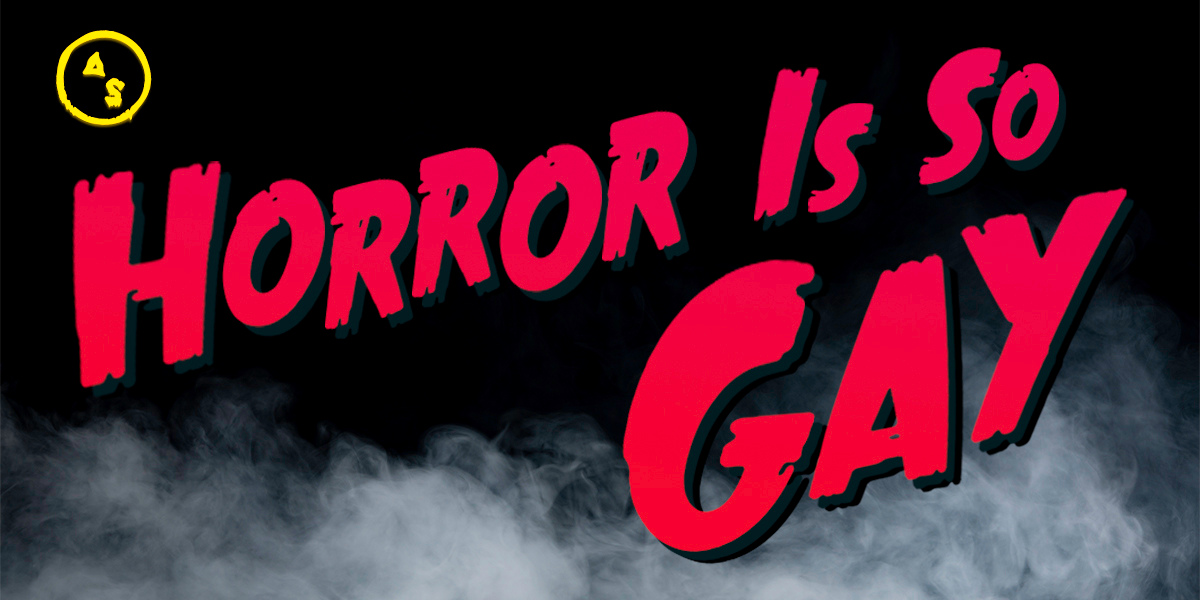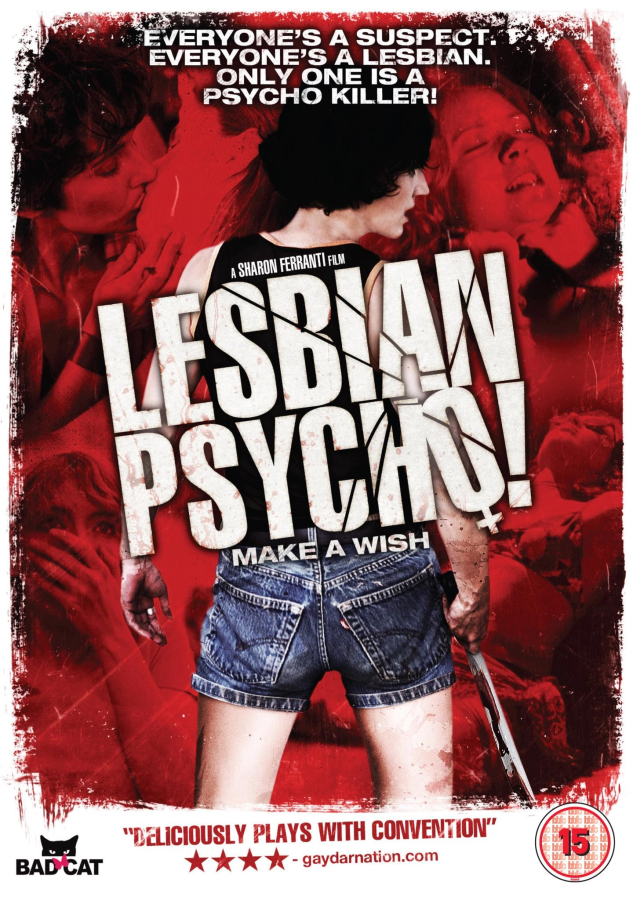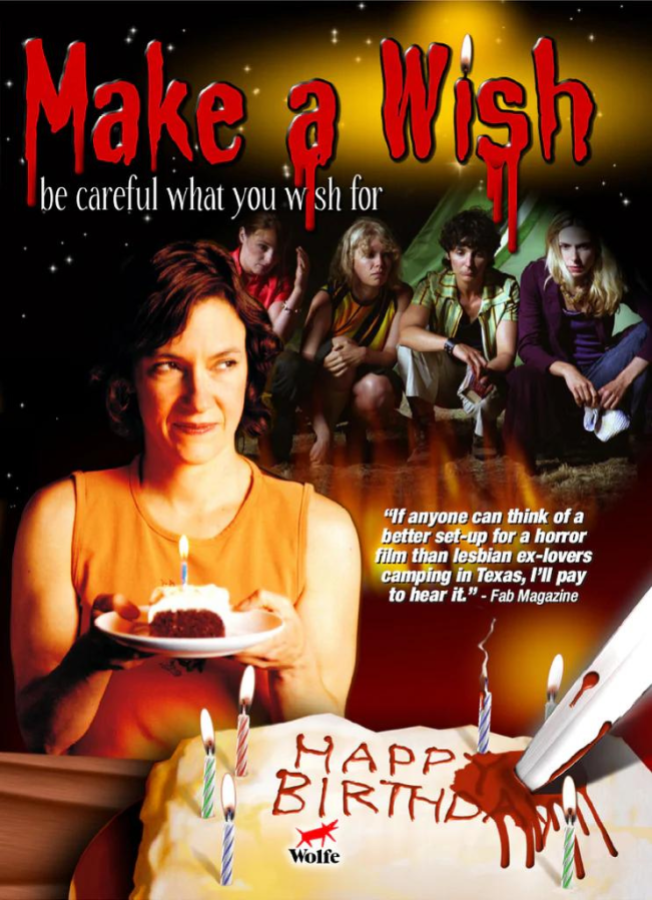
Horror Is So Gay // Header by Viv Le
As with the making of all sprawling, ambitious pop culture lists, Autostraddle’s 25 Scariest Queer Horror Movie Moments came with some challenges for Drew and I as we assembled it. We are only two people, and for as niche as some people may believe “LGBTQ+ horror” to be, there’s actually quite a lot of it. Too much, in fact, for two people to really tackle. For as many movies as the two of us had already seen or at least known about, there were still some surprises, some strange treasure we uncovered in our hunt for queer scares and frights. Perhaps the greatest of those discoveries we made was the 2002 lesbian slasher Make a Wish.
I am a dyke and a lover of slasher movies, and I had no clue Make a Wish — very much so billed as a dyke slasher — existed. I was immediately enchanted by the summary I read on Letterboxd:
A woman, lost at night on a country road, is murdered. The next day, six women gather at a wilderness park for a camping weekend in honor of Susan’s birthday: Chloe, Susan’s first girlfriend; Dawn, her most recent one; Linda, Susan’s former lover now back with Steve, who has followed Linda and spies from a distance; and, Monica who used to be with Susan but is now with Andrea, who’s tagged along. They all know who cheated on whom in the Susan saga, plus they flirt or complain in turn. A fugitive may be on the loose in the park, with a private eye in pursuit. A crossbow, a blowtorch, a knife, and an animal trap figure in subsequent murders. Who’s the killer, and who survives?
And if that hadn’t already sold me, there was also this trailer:
This became my own personal horror movie: If I did not immediately get my hands on this movie from two decades ago, I would surely die.
But this proved a difficult task. Make a Wish is unavailable to stream or rent anywhere online. It’s the only feature film made by its director Sharon Ferranti, and it was originally distributed by longtime LGBTQ+ distributor Wolfe Video. You can buy the DVD for $7 from Wolfe or used from media resellers. Drew and I both ended up buying our own DVDs of the movie without knowing if it would be any good or if it would be scary enough to warrant a place on our already very stacked list, but we wanted to own Make a Wish even if just for archival purposes. The movie is even difficult to research, as it was also briefly released under the title Lesbian Psycho and with an entirely different poster aesthetic that evoked more of a 70s sexploitation slasher vibe:

But then seemingly went through a major rebrand, retitled as Make a Wish and given a new poster that, minus its blood drips, looks more like just a low-budget indie drama:

For what it’s worth, I personally prefer the Lesbian Psycho branding, but I also understand how that might have ostracized the movie’s core audience, given how the lesbian psycho/lesbian killer trope often has received community backlash, as evidenced by protests against Basic Instinct a decade prior to Make a Wish. But were these choices made to make the movie more palatable for dykes or more palatable for potential distributors and also straight audiences given that by 2002 some of the more salacious 70s horror fare was no longer en vogue and in fact was typically regarded as gross? Either way, I’m not that interested in palatability in queer art.
In any case, Make a Wish is now practically a ghost. So many queer movies get lost over time.
And researching Make a Wish, it’s easy to see why it happened. The movie did some festival rounds, including at the San Francisco International LGBT Film Festival in 2004. In fact, at that same festival in that same year, Hellbent, a slasher centered on gay men was also screened. Hellbent, however, has had a lot more staying power than Make a Wish, and I honestly don’t think this is simply boiled down to the fact that Hellbent is a better movie (even though it is). I do think there’s some lesbophobia behind Make a Wish‘s cultural vanishing. “Lesbians camping in the woods” doesn’t exactly have the same thrill factor as “gay boys at a kinky Halloween dance party” — but Make a Wish does indeed feature just as much queer sex and, while its script is very uneven in terms of its horror constructs, it does very much feel like a movie made by and for lesbians, its relationship dynamics and sense of humor authentic and never once catering to straight viewers.
As that wild summary above details, Make a Wish is a movie about a lesbian named Susan who everyone wants to date but also everyone wants to cheat on. For some baffling reason, she has an annual camping trip with all of her ex-girlfriends, who all cheated on her, except her most recent ex, Dawn, who is a witch. One-by-one, they’re killed off in over-the-top slasher fashion by an unseen assailant. The only Black character is the first to die, and the twist at the end is equally uninspired and therefore easy to see coming. There’s some casual biphobia in there, too. Make a Wish isn’t exactly inventive in form nor as smart as it believes itself to be. There’s a second twist after the initial twist that is so confusing I thought my DVD was damaged and something had been skipped. But no, it just doesn’t make sense, and even Ferranti’s director’s commentary in the bonus features doesn’t provide much clarity. If you do get your hands on the elusive DVD and watch it and understand what the fuck is happening at the very end, please, do tell. I would love to know.
And yet, despite the film’s many problems, it’s still upsetting just how difficult it is to find and just how erased it is from discourse on queer horror. I came across the movie on accident. It was never written about on Autostraddle until Drew and I included it on the list earlier this month. From what I was able to find, it appears that all reviews of the movie in mainstream publications were written by men. This doesn’t shock me, but my lack of surprise does bum me out. The New York Times review calls it humorless which, of all, the valid critiques one could make of this movie, that’s not anywhere on my list. But calling lesbians humorless is a tale as old as time. Variety‘s review, while accurate about some of the movie’s shortfalls — and its strengths, like Jessica Gallant’s camerawork on the film’s low budget — is similarly glib. And again, I do not think this is some long-lost masterpiece, but I do think that the way Make a Wish was covered — and not covered — when it was released made it so that the film eroded over time, fading into obscurity.
While it was initially screened in 2002, it didn’t get its wider Wolfe distribution until 2004, so the movie really did ultimately come out the same year as Hellbent. Two all-gay slashers in one year is indeed a surprising coincidence, especially for a time when so few queer movies were being made period. And sometimes queer movies end up unfairly pitted against one another, treated as if there can Only Be One. I wonder how many festival or programming opportunities Make a Wish lost out on because the gay slasher slot was already filled by Hellbent. Hellbent is deserving of its cult status, but it’s not a perfect movie either. Within the already marginalized space of queer film, movies centering lesbians and bisexual women are the hardest to find, a trend that has continued on even into recent years. Based on my research, it looks like Make a Wish and Hellbent have rarely been put into conversation with each other, which seems absurd. Time Out only invoked Make a Wish briefly at the end of its micro-review of Hellbent just to say, simply, that Hellbent tops it. Again, even in the tiny amount of space granted to queer art by mainstream media, lesbians are like an afterthought.
Disappearing queer art should scare you just as much as any horror movie. Yes, even mediocre movies. Yes, even straight-up bad movies. Support film archivists and programmers who champion the ghosts of queer art. They’re keeping things alive that we shouldn’t let die.
And on that note, I’d be remiss not to end with this: I’m confident that if Autostraddle had existed in 2004, we would have been all over what was apparently the Year of the Small Budget Queer Slasher, but we weren’t alive yet. Have you heard we’re fundraising right now? Make sure we stick around so we can keep unearthing lost queer art and covering new releases that mainstream media skips.
Horror Is So Gay is a series on queer and trans horror edited by Autostraddle Managing Editor Kayla Kumari Upadhyaya running throughout October.



That trailer is WILD.
wow love that review, enjoyed the trailer
Wow the trailer!!
fascinating!